Most riders want to improve their riding. Whether the goal is to complete their first 2-foot-6 hunter course or win at the grand prix level, the desire to create a better partnership with the horse is pretty universal. And for legendary rider and clinician Bernie Traurig the recipe for that success is simple: adopt the right system of riding and then practice it relentlessly.
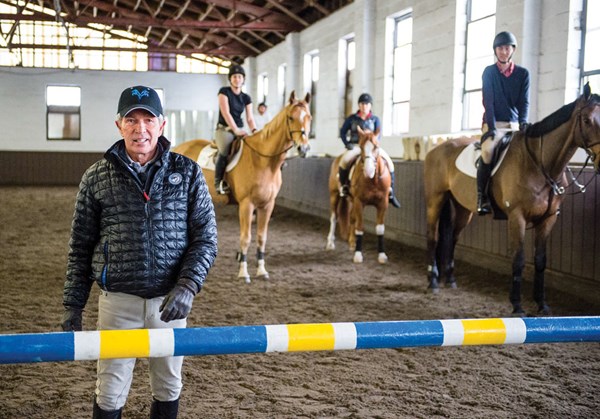
Amy K. Dragoo
“A famous pianist once said that the amateur practices a melody until he gets it right. The artist practices until he never gets it wrong,” Bernie explained to a group of riders and auditors who attended his recent workshop in Bedford, New York. “And the only way you get good at this, is to practice it.”
Bernie is a highly regarded rider, teacher and horseman. As a junior, he won both the AHSA National Hunter Seat Medal Final and the ASPCA Maclay National Championship in 1961. He represented the U.S. Equestrian Team at home and abroad (including the 1982 World Championships in Ireland) and has won more than 60 show jumping grands prix. He was inducted into the National Show Hunter Hall of Fame in 2009 and in 2010 he founded the video learning website EquestrianCoach.com.
Throughout the three days of lessons and lectures during his workshop at historic Coker Farm in Bedford, New York, Bernie emphasized that perfecting the basics of the American hunter/jumper forward riding system would propel each rider’s eventual success over fences. “We focus on the simplest of things,” he said. “Trot into a line. Halt and back up. Canter out. Halt and back up again. It’s the very basics of schooling.
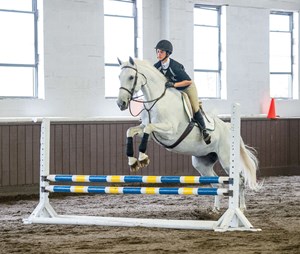
Amy K. Dragoo
“Yet everything we do here is the basis for show jumping. Horses have to instantly go forward and come back and respond to the lateral aids in both directions. You have to be in charge of the track. You practice everything you will need for the show ring.”
The forward riding system was developed by Federico Caprilli in the early 1900s. It was further refined by Brig. Gen. Harry D. Chamberlin, Capt. Vladimir S. Littauer and Gordon Wright, among other horsemen. Today, the system is endorsed and taught by George Morris and is advocated by the U.S Hunter Jumper Association Trainer Certification Program. Bernie, who trained as a junior rider under Capt. Littauer, said the system is “the basis of everything I do.
“The system we teach is based on three parts: the position of the rider, the way we use our aids and a schooling system,” he explained. “Those three parts, when they come together, make a great product.”
Dressage: Just a French Word for Training
Bernie is one of the few professionals to reach the top of the sport in all three international equestrian Olympic disciplines: show jumping, dressage and eventing. Throughout the three days, he emphasized the critical difference between the fundamentals of classic dressage and the “non-clashing aids” of the forward riding system.
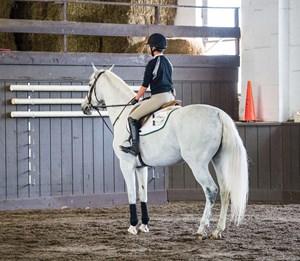
“People have confused these two systems for decades, but they are different,” he explained. “Dressage is based on the combination of coordinated driving and restraining aids. This is necessary for the sport they do, but these are highly sophisticated aids.
“It takes a long time to develop understanding in the horse and a long time for the rider to be able to delicately coordinate these aids,” he added. “Without a lengthy step-by-step process of training, coordination of aids can easily become clashing aids that confuse the horse. Or as Littauer once said, ‘a razor in the hands of a child.’”
Bernie explained that dressage is based on collection and central balance with the rider balanced on the seat. A dressage rider in a downward transition engages the hind legs by riding the horse forward with her seat and legs, riding the energy up to a gathering hand. By contrast, the forward riding system is based on forward balance and nonclashing aids with the rider primarily balanced in the stirrups.
“Our rideability comes from repetition of smooth, prompt upward and downward transitions. We ask a horse for a downward transition by closing our fingers, increasing the contact with a direct rein. If our downward transitions are practiced in a prompt way, we encourage natural engagement. The promptness of the transition rebalances the horse automatically, engaging the hind leg automatically, developing agility and strength,” he explained.
“The leg still supports the downward transition but without a forward-driving effect,” he elaborated. “Therefore, it’s a non-clashing aid. In its simplest form: legs to drive forward, hands to come back.”
Tiffany Avon was struggling with downward transitions with her 12-year-old gelding Forever Z. It gave Bernie an opportunity to demonstrate how her clashing aids confused her horse. “In the canter downward transition, you sink, don’t sit and you open your upper-body angle a little bit. You are always in balance with the horse, but don’t sit too early as he begins the transition or the seat will act as a driving aid,” he explained. “Just sink and be light—you could put a piece of paper between your butt and the saddle.” She lightened up in the saddle and Forever Z gave her crisper transitions.
Make Your Warm-Up Productive
Each of the riders was challenged to warm up their horses thoughtfully, using basic but specific exercises to make their mounts attentive and reactive to the aids. “Every moment in the tack you are either training or untraining your horse,” Bernie declared.
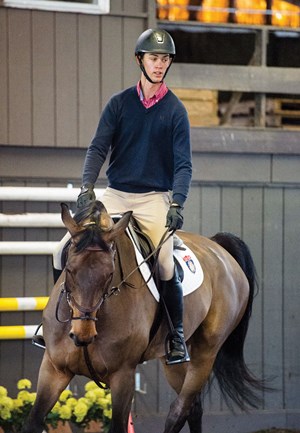
Amy K. Dragoo
He encouraged the riders to start their sessions with a forward walk with impulsion and rhythm, adding that “there are only two ways to walk: a relaxed walk with a long and loose rein or with contact, marching forward and following the neck movement. And NOT on the cell phone,” he added emphatically. “Think of discipline, think of making every minute productive.”
After asking riders to create an elastic contact with their horses at the walk, Bernie moved into a series of exercises, including upward and downward transitions, lengthening and shortening, circles and half circles, serpentines and halts. He challenged the riders to be specific in their warm-up choices.
“So am I going forward because he is behind my leg? Am I using an open rein to turn him sharply? Am I going deeper in the corner because he’s avoiding the corner? Am I doing walk–canter transitions because he’s fresh? What’s your plan?”
Phillip Williamson, one of two former USHJA Emerging Athlete Program riders who received grants from Bernie and the USHJA Foundation to attend the clinic, demonstrated a suppling exercise for the neck. “Horses are stiff and usually have a stiff side on the left,” Bernie explained. “This is a great way to loosen the neck up.” He had Phillip put his gelding, Edingburgh, on a small circle to the left then widen his inside hand and apply pressure directly back outside his left hip. “It is a bit awkward. You tactfully overbend the neck, wide left hand, hold until something gives. As soon as he softens up, go back to the normal bend. The timing has to be good. If you hold the bend and let go before he gives, it is meaningless. Hang in there until something melts.”
As the riders loosened up their horses, Bernie encouraged them to work toward being prompt in their transitions. “When you turn your horse out in the field and he is fresh, he may passage or piaffe. Then he is running to the gate and you think he is going to jump it. But he stops in three strides. And he can stop because he is using his hind end. That is natural engagement,” Bernie explained. It is the promptness demanded in upward and especially downward transitions that encourages a horse being ridden to engage the hind end naturally and improve his balance without the rider’s driving leg, Bernie said. “Littauer taught this. Our system won’t work unless you practice promptness. You do thousands of these transitions to make your horse rideable. It doesn’t happen in a day.”
He used the canter depart as an example of where riders needed to perfect their transitions. “If you put your leg back and the horse doesn’t pop into the canter, you get haunches-in. The horse has to react to your leg instantly,” Bernie said. In a canter depart to the right, “left leg back, lighten your hands and ask for the canter. That’s simple sign language for canter at a basic level.”
Mobilize Your Leg
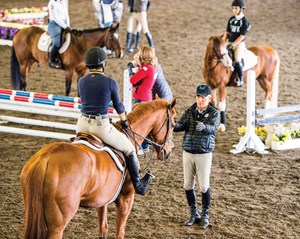
Amy K. Dragoo
Creating a deep heel and the ability to change the position of the leg are critical to being effective, especially during downward transitions, Bernie emphasized. He described three potential options for the leg: the normal position with the stirrup leather straight up and down; a displacing leg, set farther back to affect the haunches, used for canter departure and haunches-in/out, counter-canter, etc; and a braced leg, where the heel is driven down and the leg moved slightly forward of the vertical.
“You know, you are taught to sit and don’t move,” Bernie explained. “Nonsense. You need mobility and range of motion. It’s called mobilizing your lower leg.”
He worked closely with Nancy Buzzetta, who was struggling to achieve a crisp halt with her horse, Shimmer. During downward transitions, her leg was slipping back and her heel was sliding up. “You are giving him two different aids accidentally by losing your position,” Bernie explained to her as he grasped her lower leg. “He can feel a fly on his skin. Your leg goes back, and you are squeezing and brushing him with your heel. See that tickle spot there? He can feel it, and this is sending your horse forward.
“Not to withstand that if that horse stumbles or stops, you are a missile over your knee,” he added. “You need a deep heel, a stable leg in the halt. If necessary, a bit of a braced leg. This stabilizes you in the tack.”
Bernie explained the benefit of exaggeration in training. He stood in front of Nancy’s horse and told her to “waterski” her legs. “Show me the soles of your feet,” he demanded. “Just shove that foot right to his elbow.” He then had her trot around with her leg in and out of a braced position.
“It is a half-inch difference between toppling over your knee and stability. We can’t change it if we don’t exaggerate it. I want you to think ‘soles of my feet’ before you increase contact in a downward transition. If you do that exercise, if you are disciplined, you will fix it in a month.”
The ‘Epidemic’ of Inside Leg to Outside Rein
The group addressed a popular concept that Bernie emphasized was misunderstood, overused and overtaught.
“It started because many people would go through a turn abusing the inside rein diagonally across the wither, overbending the horse. Many trainers started to preach inside leg to outside rein to help people keep their horses straighter,” Bernie explained. “What has happened is an epidemic, a virus, of inside leg and outside rein.”
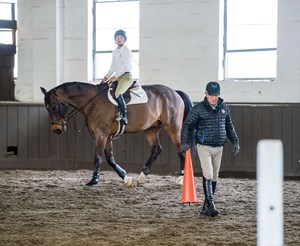
Amy K. Dragoo
He said that inside leg to outside rein is useful in many situations for more sophisticated horses and riders. “Shoulder-in, shoulder-in on a circle, engagement of the hind leg, straightening effect—all great examples of use of the inside leg to outside rein. But your inside hand and outside leg still play a part in the orchestra.”
Bernie doesn’t stress the technique for intermediate riders, however, especially on hunters and jumpers. “We have two hands and two legs. I would like both the rider and horse to understand and obey all rein and leg effects, coordinating them properly where they apply, before they focus on inside leg to outside rein.”
He suggested that intermediate riders adopt a simpler technique. If their horses were simply cutting a corner or popping a shoulder inward, they should move both hands, separated “as if they had a steel bar between them,” together toward the outside. On the left lead going around a corner, for example, this would mean using a right opening rein and a slight indirect rein in front of the wither toward the outside, adding a little inside leg for support.
“If I want to ride a turn or change my track, this is where you use your hands together,” Bernie explained. “The indirect inside rein affects the shoulder toward the outside and it gives us a little shape of the neck; it flexes the horse. The right opening rein slightly holds the horse out in the turn and the inside leg is applied.”
Bernie had the riders practice the technique by trotting straight toward him then moving the front end of the horse toward the arena wall. “Keep our hands separated— two hands steady, connected by that steel bar. Move both hands toward the wall,” he coached the riders. “You are affecting the shoulders of the horse. The hindquarters will follow. Once you practice this, it becomes invisible. You barely move your hands toward the outside and he moves over. Bending lines, controlling shoulders on short turns, it is so useful.
“All those horses I rode, all those hunters, you would see nothing—invisible aids— and they moved laterally like cutting butter. It’s a beautiful thing,” Bernie added.
Shape Your Track to Nail Your Distance
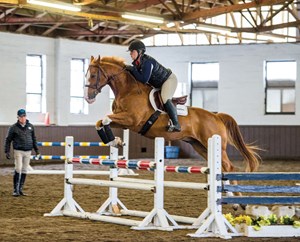
Amy K. Dragoo
The ability to control the horse’s shoulders and move them laterally (to “shape out” in a turn) became critical as the riders advanced to exercises over fences. Bernie set a challenging bending line that started with a tight right turn out of the corner to an oxer then six or seven strides to a vertical. He wanted the riders to go deep into the first corner and jump the fence on an angle toward the direct line to the vertical for six or jump the oxer straighter and ride a bending line to the vertical for seven. Most of the riders struggled to get it right.
“This is very difficult, to shape this tight turn. Most people can’t do this because they don’t have control over the shoulders,” he said, eventually placing an orange cone in front of the oxer to force the riders to ride farther out to angle the fence. “Use your hands together to shape out and set up that angle. Or get that first early distance and then a quiet seven in the bend.”
Bernie emphasized that once a horse was responsive to the aids, the rider could shape the turns and control the track to improve a difficult distance. “Manage the track according to what you see. Don’t commit to the track until you see your distance.
“Where do you think this might come in handy?” he asked. “In a bending line, if I want to use the wide track I use my hands, shift them out and the horse would move right out. Beautiful! Or in a tight rollback. Maybe when I face the jump, I don’t like the distance. I’m going to shape it out and now there is a nice distance because I have changed the track.
“Shape it out until you see it or until you like it,” he concluded.
As the riders practiced controlling the track over higher fences and with tighter turns, Bernie warned them not to create a track that left less than three strides to the fence. “Three strides out is very fast on a jumper. Watch the videos of the best in the world. They are rarely less than three strides out to the big oxers. It gives you time to work a situation out,” he counseled.
Be Purposeful in Your Practice
At the end of three very intensive days of training, Bernie reminded each rider of specific techniques that he or she could take home and practice. He recommended using poles on the ground or low cavalletti to reduce the wear and tear on the horses.
“What is the most important part of your body in riding?” he asked. “Your brain. This is a thinking sport, right? Don’t get in a hurry and do it again, do it again,” he said. “No. You stop and think about what went wrong and make a plan to correct it.
“The only way you get good is to practice. How do you practice? Daily poles on the ground. You see these cavalletti? If your stable permits, you do hundreds of them. Keep at it until you’re an artist at it.”
Bernie’s Basics On Bits
Bernie Traurig shared his belief in using the mildest bit possible for a horse, taking into consideration the rider’s ability as well. On several horses in the clinic he switched out more aggressive bits for what he called “the basement bit”—a rubber dee-ring snaffle. “This gives us a baseline for the mildest bit, and we can work up from there,” he said.
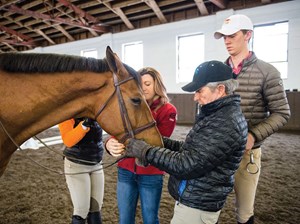
Amy K. Dragoo
“Don’t put anything sharp in his mouth because he has to submit to pressure. If the bit is too strong, he can’t take the pressure. I want him to obey my rein aids nicely without pain. A strong bit might work for you in the ring, but not for training.”
A good example of this philosophy was Caroline DeVincenzo’s horse, Keaton, who showed up in a twisted full-cheek bit. On the second day, Bernie switched the horse into a rubber dee-ring snaffle.
“We saw some impressive results with this horse,” Bernie said after the horse worked in the milder bit. “On the first day he was angry, kicking at her. He wouldn’t stand still and he wouldn’t go forward. He was unhappy in his mouth, he had pain. He was sticking off the ground yesterday, afraid of the bit.
“We put him in a rubber dee, she had plenty of forward. I am loving this: by downsizing the bit, he is accepting the pressure and you are now able to school the horse. He is accepting the milder bit and even giving you flexion. Little by little, it will come. He is a trainable horse in a rubber snaffle.”
Bernie advised the group that most horses could be ridden without the gimmick bits that “deviated from the classical. You’ve got to experiment with horses. Just put a normal bit in his mouth and see if he likes it better.”
Go to www.PracticalHorsemanMag.com for more from Bernie Traurig about the American forward riding system and clashing aids. For more information on Bernie Traurig’s clinics and workshops, go toEquestrianCoach.com and click on clinics/workshops.
This article originally appeared in the August 2016 issue of Practical Horseman.










